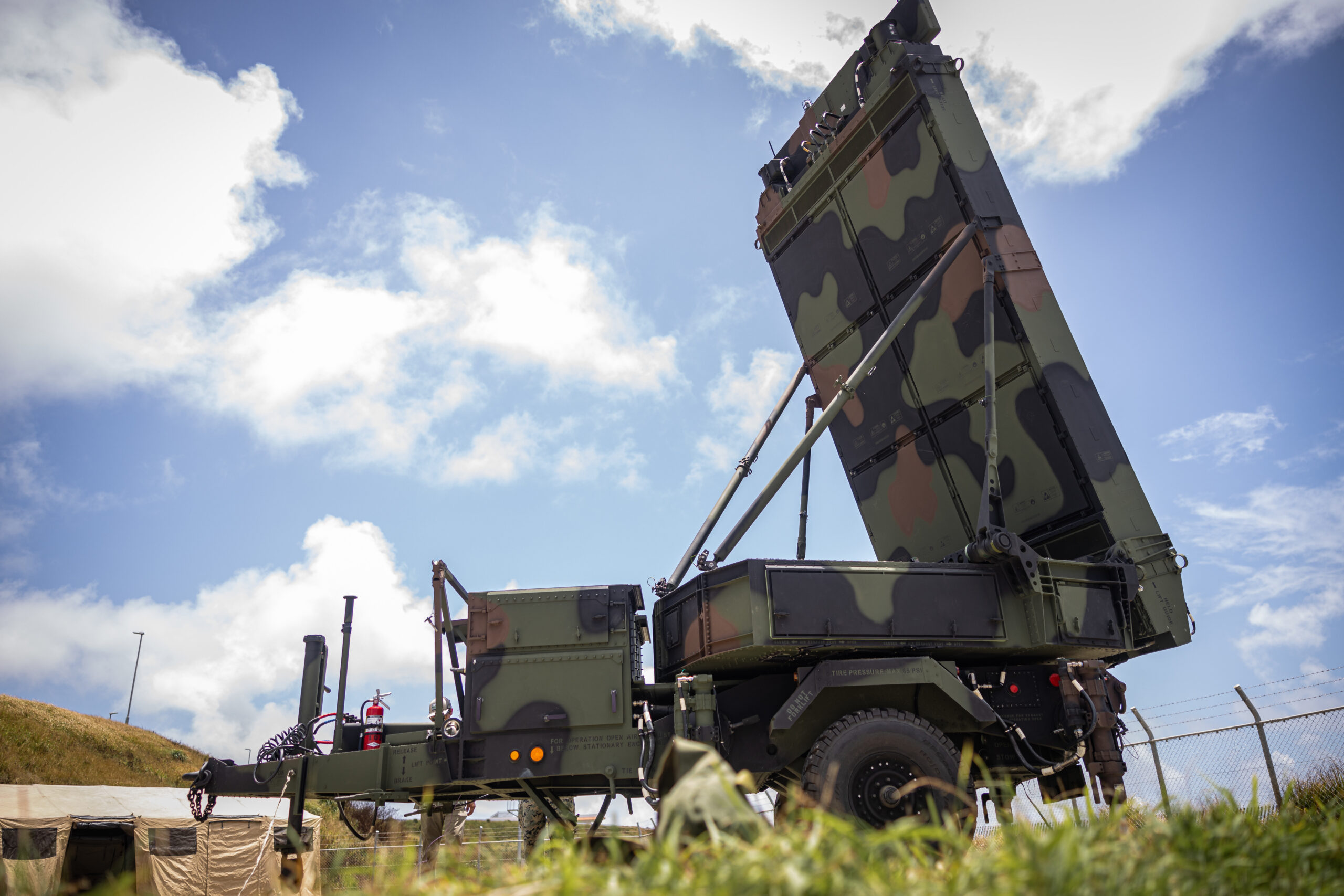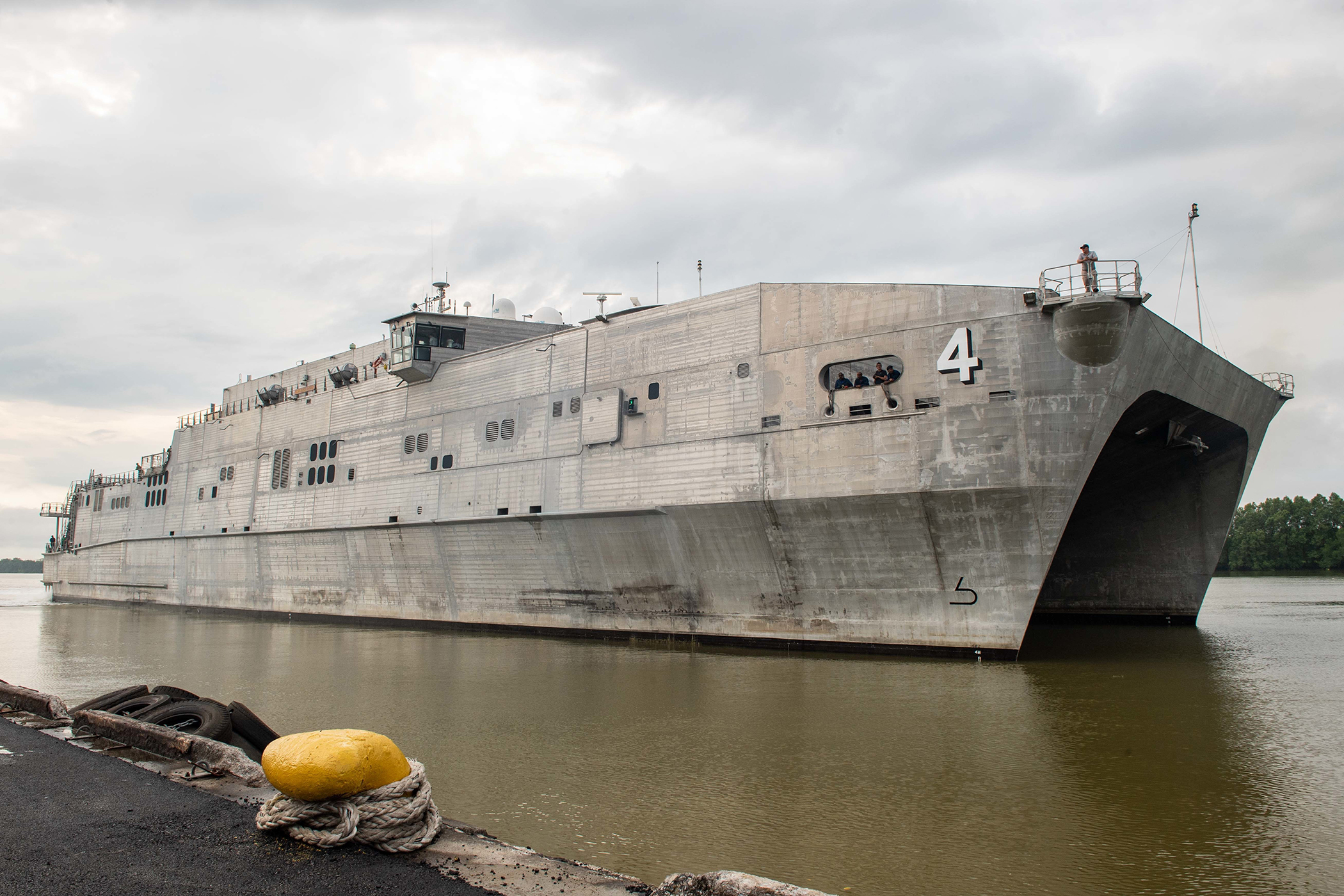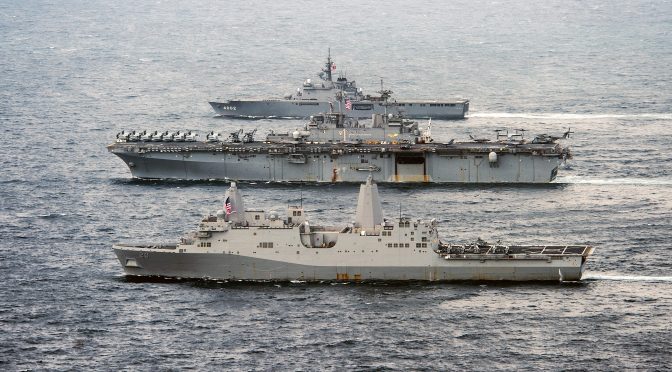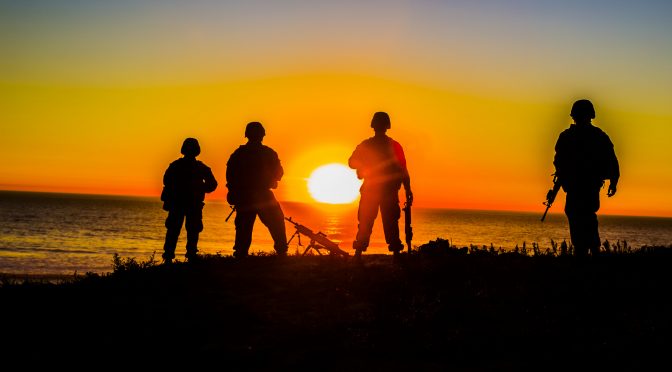By Aaron Barlow, Patrick Reilly, and Sean Harper
Introduction
As the Marine Corps prepares to contest the regional superiority of the People’s Republic of China (PRC) in the Indo-Pacific alongside the Navy and the joint force, the service must strengthen its organic killchains and ensure that each new capability acquisition aligns to the concepts that the service must execute. While joint integration will rightfully remain critical to successful campaigns, the Marine Corps – as the isolatable forward edge of the joint force in the Indo-Pacific – must ensure that its presence adds credible theater combat capability even when joint sensing, communication, and fires cannot support the stand-in force. The Marine Corps should therefore focus on acquiring platforms that present a different risk profile than the joint force; prioritize organic ownership of all components of certain killchains from sensor to shooter; value resilient, risk-worthy platforms over the highly capable but expensive; and focus on diversity and depth in the types of munitions it brings to the fight.
Strategic Context
Over the past five years, the Marine Corps has confidently and rapidly altered its force structure to meet changing national strategic priorities. As articulated in the 2018 National Defense Strategy (NDS) and echoed in its 2022 sequel, the United States must meet the 2020s as a “decisive decade” and defend U.S. national security interests by effectively deterring its adversaries, using the People’s Republic of China (PRC) as a benchmark to measure the pace of advancement. In an August 2024 report, the Commission on the 2022 NDS charted the Marine Corps’ modernization progress to date, stating “The service deserves high marks for displaying the agility that DoD often yearns for but rarely achieves.” The report further lauded the Marine Corps’ Force Design efforts as a “coherent way for the Marine Corps to operate in the Indo-Pacific against the pacing threat while retaining the ability to serve as the nation’s emergency response for crises as they materialize.”
However, the 39th Commandant’s Planning Guidance recently reinforced that modernization remains a “righteous” but incomplete journey. Using the service’s Concept for Stand-in Forces as a yardstick, recent acquisitions overestimate and over-rely on the availability of joint and national capabilities in the highly contested environment in which they must perform. Equally, other acquisition and force design decisions seem fundamentally misaligned to stand-in force imperatives like footprint, signature, and risk minimization.
The value proposition of stand-in forces best manifests in the context of a hypothetical PRC campaign to achieve reunification with Taiwan by force, in which the PLA will leverage its significant regional firepower advantage to assert all-domain superiority well East of the first island chain. Confronted by an adversary capable of devastating maritime precision strikes, the joint force will likely withdraw the preponderance of its high-end capabilities beyond the range of PRC threats. Further, Chinese capabilities will be focused on disrupting the long-range communications networks necessary for these high-end capabilities to close killchains from safer distances.
Nonetheless, the joint force will still require the ability to contest Chinese all-domain control in the first island chain. Enter the stand-in force, positioned on forward locations throughout the battlespace. Fighting as an extension of the fleet and joint force, the stand-in force will leverage disaggregation to create reconnaissance and targeting dilemmas for adversaries reliant on precision strike regimes. Stand-in forces will employ asymmetric capabilities and tactics to hold adversaries at risk in multiple domains, ultimately preventing the accumulation of regional superiority.
The Marine Corps’ perspective on how to execute A Concept for Stand-in Forces has evolved since the project began in 2020. The services Force Design annual updates allow us to trace this evolution. Foundational Force Design guidance initially prioritized the development of “smaller but better-connected formations that organically possess a complete killchain appropriate to echelon.” However, the 2022 Force Design Annual Update walked back this vision “from an initial focus on generating organic lethal capabilities…to a more balanced focus that includes persisting forward in a contested area to win the [reconnaissance/counter-reconnaissance] battle and complete joint kill webs.” The 2022 annual update also raises unresolved questions about what this balance might look like, reiterating that “certain capabilities must be organic to our Stand-in Forces, such as organic sensors and long-range precision fires to close kill webs when external capabilities are not present or available.”
Based on this guidance, the stand-in force’s risk of isolation from the joint force clearly persists. How intensely should the Marine Corps hedge against this risk, and how should the service define the balance it seeks? Recent service acquisitions suggest that the Marine Corps has overinvested in capabilities that are inappropriate for a stand-in force, at the expense of building robust organic killchains that provide a guaranteed capability baseline in the event of isolation.
The Value Proposition of Organic Killchains
The disaggregated nature of stand-in force formations and the tyranny of distance imposed by the littoral operating environment combine with the nature of the PRC threat to illustrate the value proposition of organic killchains. For example, consider the dependence of the combined joint all-domain command and control (CJADC2) concept on the resilience and availability of joint information networks. Under CJADC2, the joint force and partners seek to project all-domain effects by seamlessly closing killchains comprised of national and joint sensors, processors, and shooters. CJADC2 represents a legitimate integration challenge, and to date the services have been inching towards minimum viable capabilities.
The 39th Commandant’s Planning Guidance articulates how the Marine Corps sees its contributions to CJADC2: “Marines will act as the ‘JTAC of the Joint Force’ – sensing, making sense, and communicating to the rest of the Joint Force with an ‘any sensor, any shooter’ mindset.” Until recently the Marine Corps has followed in the wake of other services’ initiatives through participation in the Navy’s Project Overmatch and the Army’s Project Convergence, both of which have sought to develop and exercise the interconnectedness and interoperability required for the joint services to share information and close killchains. The Marine Corps has successfully exercised acquiring and maintaining custody of targets with organic sensors while passing this information to joint command-and-control applications, recently at Exercise Valiant Shield, which included an Indo-Pacific Command-level exercise of its Joint Fires Network. These initiatives and exercises represent obvious technical progress, but as demonstrations of concepts, they risk overestimating the reliability and availability of joint information networks in a way that unbalances the Stand-in Force in favor of brittle kill webs.
This imbalance becomes especially evident in the context of how the PLA plans to prosecute future conflicts. The PLA believes that modern warfare is not “a contest of annihilation between opposing military forces, but rather a clash between opposing operational systems.” The PLA’s derived concept – Systems Destruction Warfare – prioritizes attacking “the flow of information within the adversary’s operational system.” Under this paradigm, if the joint force envisions CJADC2 as a fundamental center of gravity that enables hard-hitting joint killchains, the PLA must view the same system as the joint force’s critical vulnerability and deploy proportional operational resources to target and disrupt it. What is the value proposition of the stand-in force if joint information networks must be available to unlock its contribution to potent joint capabilities?

To deliver on its value proposition, the stand-in force must retain the capability to hold the adversary at risk with credible killchains in contested environments when the rest of the joint force cannot. When CJADC2 is uncontested and operating at its peak it will make extensive use of C2 platforms in the air and space domains. However, the questionable survivability and persistence of these platforms is in part the impetus of the stand-in force concept. Thus, reliance on these high-end joint networks introduces a contradiction in the stand-in force’s conceptual framework.
A potential overestimation of the resilience of emerging commercial, proliferated low-earth orbit constellations also underpins the Marine Corps’ conceptual reasoning. Systems such as SpaceX’s Starlink may indeed enable a more robust space-based command and control architecture compared to legacy systems. However, these constellations have increasingly been touted as a communications panacea, especially after Starlink’s success in Ukraine. Meanwhile, adversaries are rigorously searching for effective counters, hunting for exploitation opportunities, or developing options to remove the space layer altogether. Though a credible 21st-century force cannot ignore emerging space layer technologies, the Marine Corps should not overestimate the resilience of commercial P-LEO solutions at the expense of organic spectrum-diverse information networks.
Earlier this year, the Marine Corps initiated Project Dynamis as a service bid to gain initiative in shaping contributions to CJADC2. The Marine Corps should leverage this opportunity to refocus command and control modernization to better align the service’s balance of information capabilities with the stand-in-force concept. The service should specifically refine robust, diverse information capabilities that enable the stand-in force to contest adversary all-domain control in ways that multiply combat power through the availability of joint networks, but crucially do not require them. Further, the end-to-end organic ownership of certain critical killchains by the stand-in force has the dual benefit of providing a credible means of contesting all-domain control when the joint force cannot be present and providing an alternative information path for the joint force inside contested areas.
An Organic and Asymmetric Munitions Mix
If spectrum-diverse information networks provide the connective linkages for an end-to-end organic killchain, a deep and varied arsenal of service-owned munitions must provide the kinetic edge. Though the Marine Corps has long constructed capabilities around a variety of indirect fire munitions, the 38th Commandant’s Planning Guidance prioritized the service’s first ever acquisition of a ground based medium-range anti-ship missile. The service’s portfolio has since grown to include Naval Strike Missiles, long-range anti-ship missiles, and Tomahawk cruise missiles, each in different phases of acquisition and with varying concepts of employment. While these munitions will provide the stand-in force with the capability to hold high-value targets at risk, they also represent relatively high-cost, low-density investments. Deriving estimates from total program acquisition costs published in the Department of Defense Fiscal Year 2024 Budget Request, the Naval Strike Missile (90 units), Tomahawk (34 units), and long range anti-ship missile (91 units) carry units costs of $2.32M, $3.09M, and $7.02M respectively.1
The per-shot expense of these munitions raises questions about whether the Marine Corps will have the magazine depth to necessary to sustain a protracted sea denial campaign. Additionally, the many lower-tier maritime targets that the stand-in force could easily hold at risk may not rise to the threshold of significance necessary for engagement with low density munitions; if the stand-in force cannot engage these targets it forgoes opportunities for credible sea denial contributions. The acquisition of exquisite medium-range munitions should not be abandoned, but greater diversity and depth in the Marine Corps portfolio of munitions could enable the service to operate more effectively as a stand-in force.
For example, a large arsenal of relatively low-cost loitering munitions will provide the stand-in force with an asymmetric advantage against littoral targets, since a single operator can control multiple munitions that cooperatively overwhelm adversary air defenses. Practical munitions trade-offs could also reduce the volume of information exchange necessary to execute killchains. For example, capabilities imbued with a layer of autonomy, such as kamikaze drones and suicide surface and sub-surface vehicles may reduce the required frequency and fidelity of sensor and operator inputs compared to traditional munitions, unburdening limited network resources. The Marine Corps should therefore intentionally balance its high-cost fires systems with deep magazines of effective yet relatively inexpensive loitering and one-way attack munitions.
Matching Capabilities to Concepts
As the Marine Corps considers the appropriate balance of organic and joint investments, the service should also consider how well its future platforms align to the concepts the service must execute. The 38th Commandant’s Planning Guidance clearly defined the types of platforms appropriate to future amphibious and stand-in forces: “We must continue to seek the affordable and plentiful at the expense of the exquisite and few when conceiving of the future amphibious portion of the fleet.” Equally, stand-in forces must “confront aggressor naval forces with an array of low signature, affordable, and risk-worthy platforms and payloads.” The latest 39th Commandant’s Planning Guidance suggests that the service has not wholly altered this philosophy, reiterating that the service must “not design our own exquisite low volume platforms.” However, considerations of affordability and riskworthiness do not receive explicit mention.
The Marine Corps should not compromise on cost and risk here. As the service constructs killchains, it should avoid the pattern of investing in expensive, exquisite, and excessively overengineered platforms that directly mirror or present the same risk profile as existing joint capabilities. The service should instead focus acquisitions on platforms that diversify the risks faced by the joint force. Marine Corps platform attributes should closely resemble the original value proposition for Force Design and A Concept for Stand-in Forces: highly expeditionary, risk-worthy, operationally and logistically supportable in protracted conflict, and respectful of the fiscal realities faced by the service.
As an illustrative example, consider the Marine Corps’ recent acquisition of the MQ-9A Reaper platform, part of a service unmanned aerial system strategy that actually preceded Force Design. Now integrated into air combat element formations, the MQ-9A provides the service with a credible organic long-endurance airborne surveillance and command-and-control capability in competition. However, recent battlefield evidence suggests that the Reaper may not be survivable when targeted in conflict without additional supporting capabilities. Iranian proxy groups, most notably Yemen’s Houthi rebels, appear to have downed at least four MQ-9s since October 7, 2023 (and possibly far more, with acknowledged numbers increasing frequently). If affected today, these losses would halve the Marine Corps’ current fleet of MQ-9A platforms, or quarter the projected fleet in 2025. Unmanned aerial system operations in Ukraine also offer insights into the utility and survivability of large, loitering unmanned platforms in peer conflict. Though used to great effect at the outset of the war, recent reports have suggested that Ukraine has significantly curtailed the sorties flown by their Turkish Group 5-equivalent Bayraktar TB2 drones, due in part to the deployment of a more sophisticated Russian integrated air defense network along the front. Further, a platform with a 3000-foot runway requirement and a unique maintainer MOS arguably does not conform to Force Design and stand-in force principles like footprint and signature minimization. Finally, though not a novel and exquisite platform, the service’s MQ-9s do not seem fiscally risk-worthy at the current rate of acquisition, especially considering recent shoot-down rates. In FY2024, the Marine Corps paid an effective unit cost of $37.5M each for five MQ-9A platforms, which would provide a Houthi-equivalent adversary with several months of target practice. The PLA is likely another story, and the MQ-9A will almost certainly be a priority target based on the platforms’ potential value as killchain enabler.
General Atomics, perhaps sensing that the service lacks compelling alternatives, appears ready to upsell the Marine Corps on the more capable but likely far more expensive MQ-9B in the near future. At present, while the MQ-9A may serve as an invaluable enabler in competition, the platform appears too rare, too capable, and too imminently targetable to persist and survive as the stand-in force transitions to conflict.

Consider instead the application of a different solution paradigm to the same problem: the acquisition of high numbers of comparatively low-cost medium-size semi-autonomous unmanned aerial systems (UAS) like Shield AI’s V-BAT or the Platform Aerospace Vanilla UAS to support surveillance, command and control, and targeting missions. Distributed throughout contested areas, launched from austere locations under vertical/short takeoff and landing regimes, and operated in swarms with a different payload on each airframe, these platforms could support or heavily augment large, low-density systems like MQ-9A in conflict. In one-to-one comparisons, medium UAS clearly cannot match the capability of larger systems like MQ-9A. However, when operated at scale and especially when integrated with other long-range littoral sensors, medium UAS platforms can provide an acceptable solution to the stand-in force’s surveillance and command and control requirements while presenting an asymmetric cost and targeting dilemma to adversaries.
While we have focused on the MQ-9, the Marine Corps portfolio is replete with platforms that carry similar contradictions when examined through the Force Design and stand-in force lens. Instead of replicating the acquisitions of the past, Marine Corps should specifically develop capabilities around diverse, risk-worthy, high-density, and relatively low-cost platforms and consider reducing investments in highly capable but overly precious and concentrated capabilities that mirror those in the joint force.
The Future of Force Design
The 39th Commandant’s Planning Guidance reiterates that “Force Design remains our strategic priority and we cannot slow down.” Force Design provides the Marine Corps a unique opportunity to differentiate itself from past operating concepts and acquisition decisions while building an asymmetric value proposition in the joint fight against peer adversaries. The Marine Corps cannot afford to own every node of every kill web, but selective end-to-end ownership of specific killchains will enable relevant and credible service contributions to the joint force in competition and at the onset of a protracted conflict. Moreover, a Marine Corps with enhanced magazine depths and a plethora of affordable, risk-worthy platforms operating forward in first island chain will challenge adversary all-domain control and set conditions for US domination in the later stages of any maritime campaign. Likewise, any improvements that the Marine Corps makes in the alignment of its expeditionary capabilities to threat-informed concepts will concurrently prepare the service to effectively fulfill its role as a crisis response force, primed for contingencies in support of national mission objectives in accordance with the shifting realities of modern war.
Major Aaron Barlow, Captain Patrick Reilly, and Major Sean Harper are currently serving as operations research analysts assigned to the Deputy Commandant for Combat Development and Integration in Quantico, Virginia.
These views are presented in a personal capacity and do not necessarily reflect the official views of any U.S. government entity.
Notes
1. Data reported for USN. USMC specific data not available for FY2024.
Featured Image: U.S. Marine Corps Lance Cpl. Terrell Chandler, left, and U.S. Marine Corps Lance Cpl. Melvin Monet, both low-altitude-air defense gunners with 3d Littoral Anti-Air Battalion, 3d Marine Littoral Regiment, 3d Marine Division, set security with an FIM-92 Stinger during Marine Littoral Regiment Training Exercise (MLR-TE) at Marine Corps Air Station Yuma, Arizona, Jan. 28, 2023. (U.S. Marine Corps photo by Sgt. Israel Chincio)





